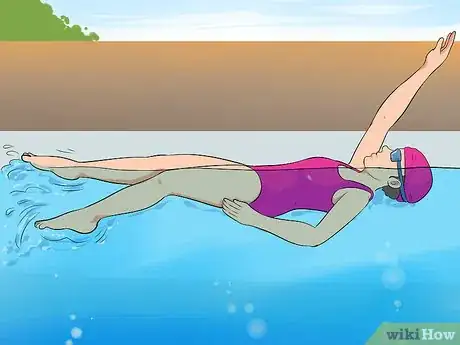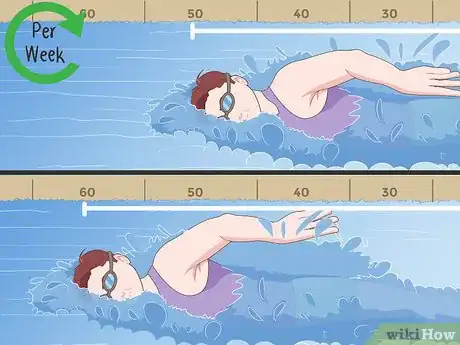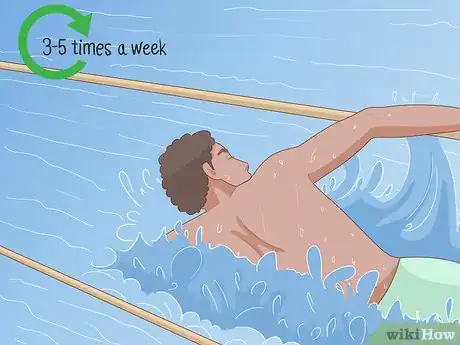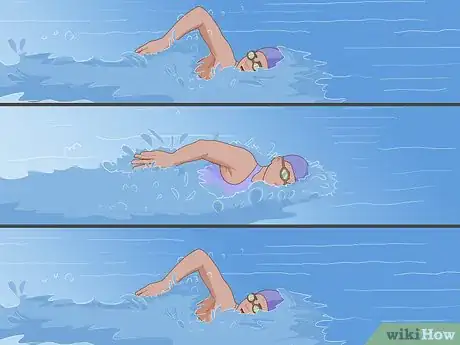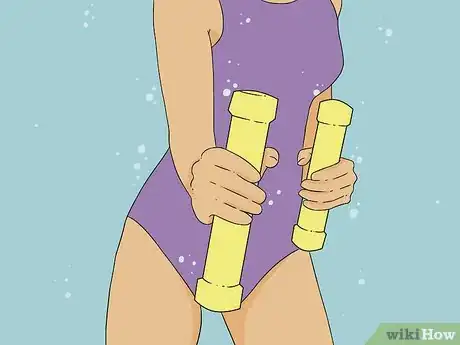This article was co-authored by Francisco Gomez. Francisco Gomez is the Head Coach at the FIT Potato Gym, a training gym established in 2001 in the San Francisco Bay Area. Francisco is a former competitive runner who helps endurance athletes train for major marathons like the Boston Marathon. Francisco specializes in Injury Rehab, Flexibility, Marathon Training, and Senior Fitness. He has a B.S. in Nutrition and Exercise Physiology & Running.
There are 11 references cited in this article, which can be found at the bottom of the page.
This article has been viewed 27,585 times.
Swimming is an excellent cardiovascular workout that tones and strengthens your whole body. It’s also low-impact, so it’s easier on your joints than other forms of exercise, such as aerobics and running. If you’re looking to lose weight, swimming for exercise can help. Start slow and build up the length and intensity of your workouts. You can also try out different forms of swimming for exercise and use tools and strategies to boost your results. With a regular swimming regimen and some other healthy changes, you will be on your way to reaching your weight loss goals!
Steps
Getting Started with Swimming for Exercise
-
1Learn how to swim if you do not know how. Before you hop into a pool and start swimming for exercise, make sure that you are a confident swimmer. You may be able to find lessons at a local community pool, college, or gym. Taking a class can also be a great way to jumpstart your exercise regimen.[1]
- The breaststroke and freestyle stroke are the easiest to learn, so start with these. Then, work on learning the backstroke and butterfly. Butterfly is probably the hardest stroke, so only attempt it if you're confident with your swimming skills.
- Even if you have decent swimming skills, taking a swim class might be helpful for improving your technique.
Tip: Make sure to learn the proper breathing technique for swimming. It's important to breathe at a regular pace while you swim. Take a breath in through your mouth on every other stroke when your mouth rises above the water.[2]
-
2Include swimming once per week to start. Swimming has been shown to have a greater effect on cardiovascular health, body composition, and strength than other forms of exercise (not to mention the endorphins released when you exercise that make you feel good), so even incorporating swimming into your exercise routine once per week will provide benefits. If one swimming workout is all you can fit in or feel up to doing, then start with just one swimming workout per week. Swim for as long as you are able, but aim for 30 minutes total.[3] If you're just starting out, you might want to swim taking breaks. For example, you can swim 15 minutes, then take a break to rest, then swim another 15 minutes.
- You could swim on Mondays, then do a different form of exercise on the other 4 days of the week, such as walking, biking, or taking an aerobics class.
- Try to swim as many laps as you can or see how many laps you can finish in a certain amount of time. Once you find your baseline, you'll be able to set a more manageable and realistic goal.[4]
Advertisement -
3Work up to swimming for 30 minutes 3 times per week. As an initial workout regimen goal, shoot for doing three 30-minute swimming workouts per week. You can do these workouts every other day, or a few days in a row, but try to decide on a set schedule that you can stick with. This will help to increase your chances of sticking with your routine.[5]
- For example, you could swim on Mondays, Wednesdays, and Fridays, or on Fridays, Saturdays, and Sundays of that’s more convenient for you.
- Experiment with swimming different times of day as well. You might find it refreshing to hop into the swimming pool after a long day, or you might enjoy taking an early morning dip to help you wake up.
-
4Aim for a total of 60 minutes swimming 3 times per week. To reap the maximum benefit from swimming, work up to swimming for 60 minutes 3 times per week. Build up the length of your swim workouts gradually as you gain strength and endurance. Depending on your current fitness level, you may be ready to swim for this length of time now, or you might need to do shorter swimming workouts for 6 months before you are up to swimming this length of time and frequency.[6]
- Try adding 5 minutes or 10% extra distance to each of your swim workouts every week.[7] For example, if you start out swimming 30 minutes per week 3 times per week, then do 35 minutes per workout the following week, then 40 minutes per workout the week after, and so on.
Incorporating Different Swimming Workouts
-
1Hold onto a kickboard and do laps. If you’re not ready to swim on your own, you can still obtain many of the benefits of swimming by holding onto a floating kickboard in the pool. Try swimming a set number of laps or swim for a specific length of time while holding onto the kickboard.[8]
- For example, you could swim 20 laps with a kickboard or swim for 45 minutes.
- You could also try using a pool noodle, floaties, or other types of swimming aids when you are just starting out.
-
2Do swimming interval training to burn more calories. Interval training is when you do a higher intensity level of exercise for a set amount of time, then exercise at a moderate pace, and repeat. This will increase the number of calories you burn in a workout and help to amplify your results. Do 5 or more intervals per session and incorporate interval training 1 to 2 times per week.[9]
- An example of interval training would be: swim at a fast pace for 1 minute and then slow down to a moderate pace and swim for 2 minutes.
- For a more intense interval workout, swim at a high intensity for 3 minutes, then swim at a moderate pace for 3 minutes, and repeat.
-
3Try water aerobics for an alternative to swimming. You can take a water aerobics class at a community pool or gym, or learn some water aerobics moves and do them on your own. These can be as simple as treading water, walking in the pool, or hopping up and down in the pool.[10]
- For example, you could walk a lap in the shallow side of the pool, then tread water in place for 3 minutes, then hop in place for 1 minute. Repeat the sequence 3 to 5 times for a simple water aerobics exercise.
Tip: Remember that as long as you keep moving while you are in the pool, you are exercising! Try out different water aerobics moves to see what you like and then do whatever feels comfortable to you to get your workout in.
Boosting Your Results
-
1Download a swimming app to keep you motivated. There are several free swimming apps that you can download onto your phone and use to help you keep track of your swim workouts, track your progress, and develop new workouts. This is a great way to stay motivated, improve your swimming skills, and build endurance. Some apps you might want to try include:[11]
- MySwimPro
- MySwimFit
- GoSwim
- Swim4Gold
- SwimIO
-
2Use a waterproof fitness tracker to record your workouts. A waterproof fitness tracker is a great option if you want to know the stats on your workouts, such as how far you swam and how many calories you burned while swimming. You can purchase a waterproof fitness tracker and wear it into the pool during your workouts.[12]
- You can get a watch or ring-style fitness tracker to wear during your swims.
- Make sure that the fitness tracker you get is actually waterproof! If it’s not, it will get ruined in the water.
-
3Join a swim club or team in your area to meet other swimmers. Finding a group of swimmers to belong to can help to keep you motivated. They might do regular challenges, fundraising events, or group swims that you can participate in. It might also be helpful to meet other people who are using swimming for fitness and weight loss.[13]
- You might be able to find a swim club at your local community pool, at the gym, or by checking on Meetup.com.
Tip: If you have a friend or family member who might like to go swimming with you, then you could ask them to join you. Having a workout buddy can help to make it more fun and keep you accountable.
Expert Q&A
-
QuestionHow can I set a swimming goal for myself?
 Francisco GomezFrancisco Gomez is the Head Coach at the FIT Potato Gym, a training gym established in 2001 in the San Francisco Bay Area. Francisco is a former competitive runner who helps endurance athletes train for major marathons like the Boston Marathon. Francisco specializes in Injury Rehab, Flexibility, Marathon Training, and Senior Fitness. He has a B.S. in Nutrition and Exercise Physiology & Running.
Francisco GomezFrancisco Gomez is the Head Coach at the FIT Potato Gym, a training gym established in 2001 in the San Francisco Bay Area. Francisco is a former competitive runner who helps endurance athletes train for major marathons like the Boston Marathon. Francisco specializes in Injury Rehab, Flexibility, Marathon Training, and Senior Fitness. He has a B.S. in Nutrition and Exercise Physiology & Running.
Fitness Coach Try to swim as many laps as you can or see how many laps you can finish in a certain amount of time. Once you find your baseline, you'll be able to set a more manageable and realistic goal.
Try to swim as many laps as you can or see how many laps you can finish in a certain amount of time. Once you find your baseline, you'll be able to set a more manageable and realistic goal.
Warnings
- Do not attempt to swim for exercise if you do not know how to. Learn to swim before you get into a pool.⧼thumbs_response⧽
- Never swim alone. If you are swimming in an area without a lifeguard (such as a lake or in the ocean), always have someone keeping an eye on you. Even very strong swimmers should be observed.⧼thumbs_response⧽
References
- ↑ https://www.prevention.com/fitness/fitness-tips/a26859164/swimming-weight-loss/
- ↑ https://www.prevention.com/fitness/fitness-tips/a26859164/swimming-weight-loss/
- ↑ https://www.sciencedirect.com/science/article/abs/pii/S0026049510000545
- ↑ Francisco Gomez. Fitness Coach. Expert Interview. 24 October 2019.
- ↑ https://www.ncbi.nlm.nih.gov/pmc/articles/PMC4625655/
- ↑ https://www.ncbi.nlm.nih.gov/pmc/articles/PMC4625655/
- ↑ Francisco Gomez. Fitness Coach. Expert Interview. 24 October 2019.
- ↑ https://www.prevention.com/fitness/fitness-tips/a26859164/swimming-weight-loss/
- ↑ https://www.obesityaction.org/community/article-library/swimming-for-weight-loss/
- ↑ https://www.obesityaction.org/community/article-library/swimming-for-weight-loss/
- ↑ https://www.bhf.org.uk/informationsupport/heart-matters-magazine/activity/swimming/5-free-swimming-apps
- ↑ https://www.pcmag.com/roundup/328228/the-best-waterproof-fitness-trackers
- ↑ Francisco Gomez. Fitness Coach. Expert Interview. 24 October 2019.
- ↑ https://www.cdc.gov/healthyweight/losing_weight/getting_started.html
- ↑ Francisco Gomez. Fitness Coach. Expert Interview. 24 October 2019.
- ↑ https://www.cdc.gov/healthyweight/losing_weight/eating_habits.html
- ↑ https://www.helpguide.org/articles/diets/how-to-lose-weight-and-keep-it-off.htm
- ↑ https://www.helpguide.org/articles/diets/how-to-lose-weight-and-keep-it-off.htm
